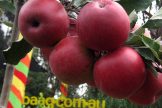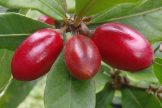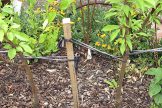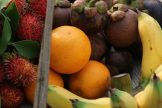
Persimmon are a highly ornamental deciduous fruit tree with dense bright green foliage, spectacular orange and red autumn colours, light grey bark, and a beautiful twisted form in old age. In same cases, the large orange fruit are held on the bare branches after leaf-fall, creating a jeweled sculpture! Height is 3-10 m, tending to under 5m in the home garden.
Growing conditions
Persimmons require full sun, constant moisture in their root zone, and a climate with warm autumns to ripen fruit (particularly the non-astringent varieties). Young trees in particular need protection from wind, a weed-free root zone and free-draining soil –rich loams preferred, but even very sandy soils are tolerated.
Mulching & Feeding
Fertilise in late winter and early summer with heavy applications of manure, and keep well –mulched to suppress weed growth.

Pruning
Train to a pyramid (central leader) shape when starting off your young persimmon. The new growth that forms on the tips of last years wood, is where fruit will be produced, meaning DON’T prune this tree allover as you would an apple! Instead, in late winter, take out alternating branches each year (and any dead, broken, crossing or diseased wood), so that you leave room for new branches to go through the two years of growth without cutting that is required for them to produce fruit. Leave the remaining branches un-shortened, as it is the growth from from the tips of this wood that will flower and fruit this year.
Persimmon wood is brittle and branches can crack if the tree is overloaded with fruit. If this is a problem (young trees are especially vulnerable), thin out the fruit.

What does astringent mean?
Non-astringent varieties can be eaten when the colour has changed to orange yellow, but the fruit is still firm. Astringent varieties can only be eaten when fruit is very soft. It should, however, be picked when full colour depth is reached but the fruit is still firm. Then leave the fruit to ripen at room temperature.






